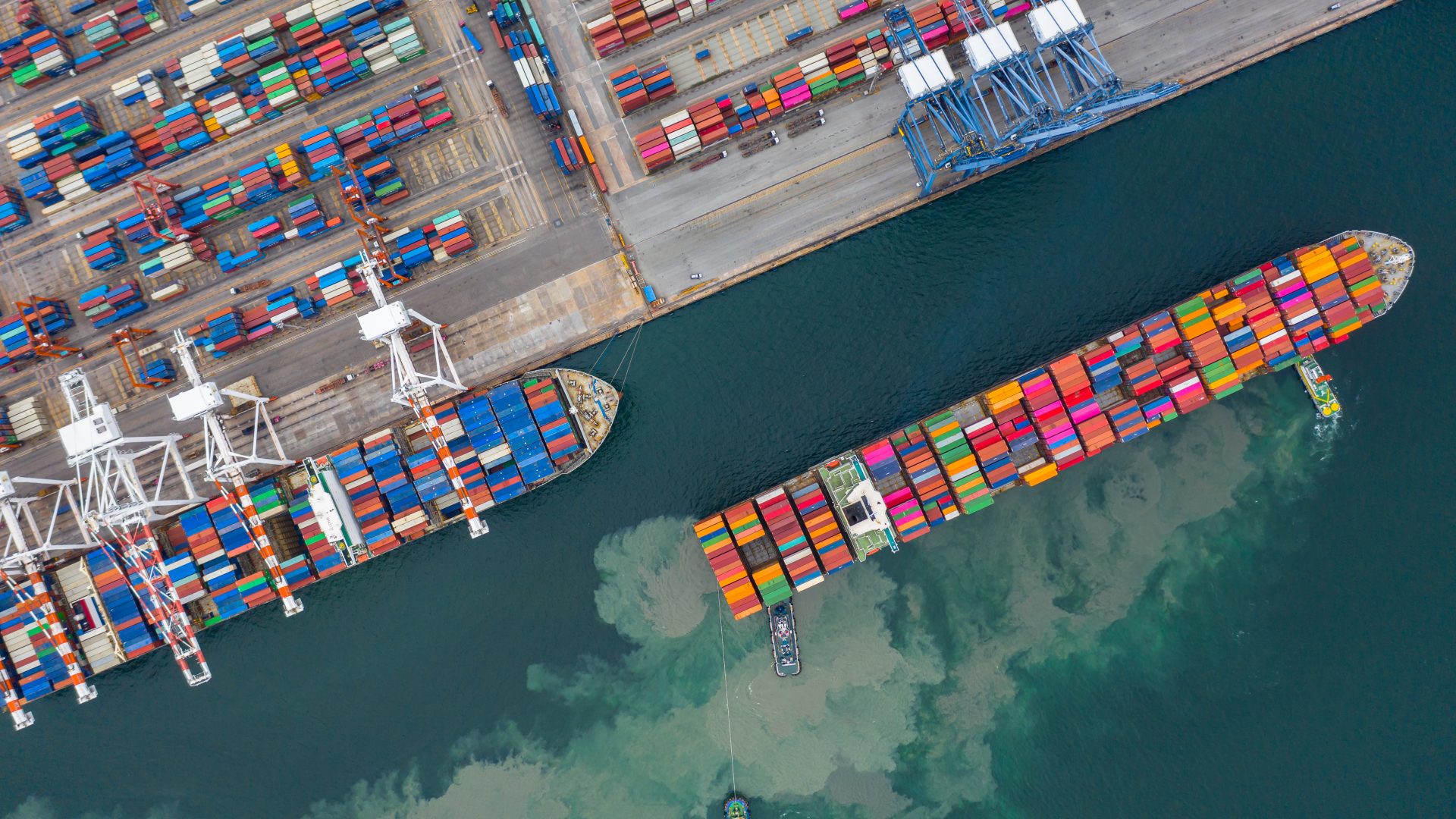
energy & environment
All at sea? – What Fit for 55 means for the maritime sector
Much of what we see around us at any given moment – be it a product, raw material or a commodity was once on a boat.
All embark on a seaborne journey from wherever processed or harvested to where it can be used or consumed. It happens thousands of times a day, on tens of thousands of vessels moving from port to port. The maritime shipping industry has been the backbone of globalisation, carrying between 80 to 90 percent of global trade flows. However, the movement of these goods comes at a price. Shipping is responsible for over a tenth of transport CO2 emissions, 3% of total global CO2 emissions and is a major source of air pollution. To narrow it down to its most blunt statistic – if the sector were one country, it would be the sixth highest producer of greenhouse gas emissions, close behind Russia and Japan. At its very core, the maritime sector relies almost entirely on fossil fuels, mainly heavy fuel oil and up until recently, shipping was the only sector in the EU which was not subject to any emission reduction target. More worrying is the fact that the impact from maritime shipping is expected to intensify if mitigation measures are not put in place swiftly. According to the 3rd IMO GHG study, shipping emissions could under a business-as-usual scenario increase between 50% and 250% by 2050 undermining the objectives of the Paris Agreement. This concerning projection is fueled by rising demand for primary resources and container transport without efficiency improvements or a market to support it.
The maritime shipping industry has been the backbone of globalisation, carrying between 80 to 90% of global trade flows. However, the movement of these goods comes at a price. Shipping is responsible for over a tenth of transport CO2 emissions, 3% of total global CO2 emissions and is a major source of air pollution.
It is not all bad news however. It looks like the maritime sector could be on the brink of a breakthrough. 2021 marks the beginning of the United Nations Decade of Ocean Science for Sustainable Development, a decade of international collaboration among stakeholders in order to create improved conditions for sustainable development of the ocean. In the European Union, 2021 also marks the release of the long-awaited “Fit for 55” legislative package, comprising 12 proposals aimed at ensuring the success of the European Green Deal. The package affects all industrial sectors, and for shipping there are four particularly noteworthy proposals:
- Revision of the European Trading System Directive
- The FuelEU Maritime Regulation
- The Alternative Fuels Infrastructure Regulation
- Revision of the Energy Taxation Directive
These proposals put forward by the Commission seek to steer the EU maritime sector towards decarbonisation. In fact, some of the proposed rules do not concern EU shipping alone, but have wider implications for international maritime shipping, which is regulated by the International Maritime Organisation (IMO). With negotiations in the European Parliament and the European Council just starting, and the French EU Council Presidency set to prioritise the advancement of the Fit for 55 package, let’s see how the maritime related proposals stack up.
It is not all bad news however. It looks like the maritime sector could be on the brink of a breakthrough.
What is being proposed
As emissions continue to swell, the European Union has put forward an ambitious yet contentious idea: to make shipping companies pay for their pollution. Accordingly, a wealth of initiatives has been proposed within the Fit for 55 package to achieve this, but there is one proposal that stands out above the rest: The extension of the Emissions Trading Scheme (EU ETS) to shipping. Putting the “polluters pay principle” at the core of its maritime carbon pricing proposal has been a key priority for many European shipowners in the lead up to the Fit for 55 release after calling on the Commission to craft legislation which reflects its importance. Consequently, the proposal appears to be overall consistent with this core goal: making polluters pay. Along with promoting the polluters pay principle, the new proposal introduces other important provisions. Viewed broadly, shipping will become subject to the Emission Trading Scheme as of 2023, with the ships presently reporting emissions under the EU MRV regulation required to purchase CO2 emission credits. There will also be a phase-in period starting at 20% coverage in 2023 and increasing to 100% in 2026. No free allowances are permitted and a strict enforcement policy has been put forward. Under the new proposal, the Commission now recognises that international shipping must be subject to emissions reductions targets as shipping companies have to pay emission allowances at a rate of 100% for travel between EU ports and 50% for travel to and from the EU. This is especially important given that the majority of the emissions from the biggest container carriers occurs during international voyages. Non-compliance is fined if a ship does not pay its emission allowances for two years, and may eventually lead to a ban from EU waters – not only for the ship in question but also for any operated by its shipping company. This proposed regulation is therefore very strict, although it will not be fully implemented until 2026, hampering potential efforts by policymakers to oversee a rapid transition away from fossil fuels.
The promotion of green marine fuels is another major cornerstone of Fit for 55, paving the way towards the decarbonisation of EU shipping. In short, the maritime sector relies almost entirely on fossil fuels. To tackle this, a new regulation called the FuelEU Maritime Initiative has been put forward to stimulate the uptake of sustainable maritime fuels and zero-emission technologies by setting a maximum limit on the greenhouse gas content of energy used by ships. To encourage ships to make this transition from traditional fossil fuels to alternative fuels (e.g. biofuels, LNG, hydrogen or ammonia) a goal-based approach has been chosen by the Commission – introducing GHG intensity reduction requirements which increase in stringency over time. More specifically, the Commission stipulates an increase of 2% in 2025 relative to 2020, ramping up to 75% by 2050 – a steep and ambitious incline. Beyond these measures, the FuelEU Maritime proposal introduces an additional requirement that, starting in 2030, ships must use on-shore power for all energy needs when docked. Same as for the ETS, FuelEU Maritime Regulation is directly binding on ship operators and non-compliance may lead to fines and being banned from EU waters.
Putting the “polluters pay principle” at the core of its maritime carbon pricing proposal has been a key priority for many European shipowners in the lead up to the Fit for 55 release after calling on the Commission to craft legislation which reflects its importance.
Alongside the enforcement of the polluters pay principle and driving demand for alternative marine fuels, greening the infrastructure is also an essential step to achieve the decarbonisation of the maritime sector. In other words, if green fuels are not available for refueling in European ports, the switch will essentially not happen. To help alleviate such challenges, the Commission has put forward a proposal to review the The Alternative Fuels Infrastructure Directive which goes hand in hand with the FuelEU Maritime Initiative. The proposal converts the directive to a Regulation encouraging Member States to bolster the availability of LNG by 2025 and onshore electrical power supply by 2030 in core EU ports. It introduces binding mandatory deployment targets for electric charging stations and hydrogen refueling stations for Member States which is excellent news for both air and climate. By requiring ports to make available onshore power supply (OPS), the new regulation promises to address the chicken and egg problem of the 2014 Directive, which in the past left it up to Member States to make their decisions based on availability of demand and cost-benefit analysis.
Last but not least, The Revision of the Energy Taxation Directive, although broader in nature, is a central pillar of the maritime transition. In a nutshell, this regulatory tool contributes to the creation of a carbon price signal capable of creating the business case for investments in alternative fuels, therefore advocating a technology neutral approach. An integral problem of the current Directive is that it does not provide equal treatment of energy supplies to the shipping industry thus hampering investments in and the uptake of cleaner technologies, such as shore side electricity, fuel cells, methanol, etc. As such, this Directive is being revised to remove the tax exemption for conventional fuels used between EU ports as of 1 January 2023. For heavy fuel oil, the new tax rate will be around €37 per tonne, LNG will initially be taxed at a rate of €0.6 per GJ, and alternative fuels will be tax exempt for a ten-year period. By creating a level playing field, the revision will help close the cost gap between Heavy Fuel oil and alternative fuels and electricity.
At a glance, it would appear that Fit for 55 ticks the box on addressing the main challenges faced by the maritime industry; […] When we delve deeper into the fine print of these proposals, it is evident that there are some loopholes which need closing and certain policy measures which could end up doing more harm than good.
Challenges
At a glance, it would appear that Fit for 55 ticks the box on addressing the main challenges faced by the maritime industry. However, this assumption would be a major oversight. When we delve deeper into the fine print of these proposals, it is evident that there are some loopholes which need closing and certain policy measures which could end up doing more harm than good. Take the EU ETS – For the first time, shipping companies will be made to pay for their pollution and international shipping has now finally been recognised through emission reduction targets. That said, there are two main issues. First, the polluter pays principle does not apply to every charter contract. In time charters (time bound agreements), the shipowner ends up paying the bill instead of the operator, who makes the decisions on fuel use, speed, cargo, volume and itinerary – all of which determine emissions. This can be solved by amending the definition of shipping company so that the commercial operator takes the brunt of the cost. Second, the limited scope when compared to the MRV is a serious flaw of the proposal. If it remains unchanged, it will likely delay price signals, prevent investments in energy efficiency and undermine the EU’s climate efforts. Similarly, the rationale behind the phase-in period is unfounded – especially when minimising maritime emissions sooner rather than later is an imperative and ultimately the cheaper and easier option in the long run.
As for FuelEU Maritime, what’s missing? Many things, actually. For starters, the risk of fossil gas lock-in is a major concern. Despite its best efforts, the proposal fails to give appropriate signals to market operators to invest in solutions based on green hydrogen. To put it simply, green e-fuels, notably hydrogen and ammonia produced from renewable electrolysis can be supplied in large quantities to the sector, however since they are still only recently developed on the market, they remain expensive and require investments in new vessels and port infrastructure. As such, liquified natural gas (LNG) and crop based biofuels have been promoted as the holy grail for compliance with the Fit for 55 targets. For now, the dual-fuel LNG propulsion is perceived as the cheapest and most mature alternative fuel option eligible until 2040 which is likely to accelerate despite offering minimal emissions reductions and releasing methane. Moreover, as bioLNG and e-LNG are projected to remain expensive, the use of drop-in biodiesel has also been given the push. While the debate about the merits of LNG has become a hot topic in recent years, the inclusion of LNG targets for the development of infrastructure along the TEN-T core network and to increase the uptake of green fuels within the FuelEU Maritime is questionable – especially given the potential deployment of electrification, hydrogen, methanol and ammonia, and not to mention the risk of “lock in”. The promotion of LNG within Fit for 55 could even slow the adoption of truly zero-carbon fuels if treated as more than “transitional”. Essentially, it doesn’t make sense to set targets for Member States on LNG infrastructure nor is it wise to continue explicit support for LNG-fuelled vessels beyond what is necessary. Instead, scarce climate-focused capital and precious time would be better served concentrating on cleaning up the existing gas infrastructure and supply routes, and building out the necessary infrastructure for sustainable maritime fuels. In parallel, the proposal could be strengthened through the designation of Carbon Contracts for Difference (CCfDs) – subsidy schemes for clean fuels to kickstart the transition.
Issues on the table which will define the future of the sector include: LNG, the polluters pay principle, the scale up of green fuels and a strong business case for investment – to name but a few. Greater attention is needed on these issues and it will be important to ensure alignment across the various marine related proposals.
Conclusion
This brings us to the main question… what can be done to tackle the problem? Well, unsurprisingly, there is no silver bullet to decarbonising the maritime sector. The marine continues to represent a highly dynamic environment with a transboundary nature and competing interests which are difficult to reconcile. As alluded to above, decarbonising shipping is far more than a technical exercise but inherently political. If left unregulated, shipping could be responsible for 17% of global CO2 emissions in 2050, according to a recent study. Without a doubt, Fit for 55 provides a promising start for a future of clean shipping. However, the onus is on the co-legislators (The Council and the Parliament) to ensure the best outcome. These negotiations will be lengthy and complex, and it is expected that it will be well into 2022 before we start seeing any agreements. Issues on the table which will define the future of the sector include: LNG, the polluters pay principle, the scale up of green fuels and a strong business case for investment – to name but a few. Greater attention is needed on these issues and it will be important to ensure alignment across the various marine related proposals. As a bloc, the European Union will lead the charge, yet it will be important to work closely with the global maritime regulator, International Maritime Organisation, such that Fit for 55 has the best possible impact. Only then, will maritime have a chance at catching up with other transport sectors.




